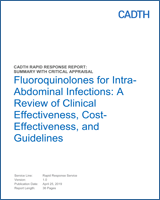| SIS (Mazuski), 201717 |
|---|
| 4. Intravenous antimicrobial agents | |
| 4.7a. “We recommend moxifloxacin as an acceptable agent for the empiric treatment of lower-risk adults with CA-IAI, although it should be used with caution in areas of the world where there is a high incidence of fluoroquinolone-resistant E. coli (Strong recommendation; high quality evidence). We do not recommend the use of moxifloxacin for empiric treatment of children with IAI unless no other options are available (strong recommendation; weak quality evidence).” (p28) | 4.7a. Strong recommendation; high quality evidence |
| Strong recommendation; weak quality evidence |
| 4.7b. “We recommend ciprofloxacin plus metronidazole as an acceptable regimen for the empiric treatment of lower-risk adults with CA-IAI, although it should be used with caution in areas of the world where there is a high incidence of fluoroquinolone-resistant E. coli (strong recommendation; high quality evidence). We suggest that ciprofloxacin plus metronidazole may be used for empiric treatment of children older than one month CA-IAI, if other options are not suitable (weak recommendation, moderate quality evidence).” (p28–29) | 4.7b. Strong recommendation; high quality evidence |
| Weak recommendation, moderate quality evidence |
| 4.7c. “We suggest that levofloxacin plus metronidazole is an acceptable regimen for the empiric treatment of lower-risk adults with CA-IAI, if use of a fluoroquinolone is warranted and it is the only fluoroquinolone available for use (weak recommendation, weak quality evidence). We suggest that levofloxacin plus metronidazole may be used for empiric treatment of children older than one month with IAI, if other options are not suitable (weak recommendation, weak quality evidence).” (p29) | 4.7c. Weak recommendation, weak quality evidence |
| Weak recommendation, moderate quality evidence |
| 6. Selection of empiric antimicrobial therapy for adult patients with CA-IAI | |
| 6.1 “We recommend ciprofloxacin plus metronidazole or moxifloxacin monotherapy for the management of CA-IAI in lower-risk patients who have serious b-lactam allergies (strong recommendation; high quality evidence), and suggest levofloxacin plus metronidazole as an alternative if no other fluoroquinolone is available (weak recommendation, weak quality evidence).” (p33) | 6.1. Strong recommendation; high quality evidence |
| Weak recommendation; weak quality evidence |
| 6.3. “We do not recommend addition of an adjunctive aminoglycoside or fluoroquinolone to a b-lactam agent for empiric management of CA-IAI in higher-risk patients (strong recommendation; moderate quality evidence).” (p35) | 6.3. Strong recommendation; moderate quality evidence |
| 6.5. “We suggest use of a fluoroquinolone-based regimen for initial empiric antimicrobial therapy of CA-IAI in lower risk patients who have had major reactions to b-lactam antibiotic agents (weak recommendation; moderate quality evidence).” (p36) | 6.5. Weak recommendation; moderate quality evidence |
| 6.6. “We recommend against empiric use of most cephalosporin-aztreonam-, or fluoroquinolone-based regimens for empiric antimicrobial therapy of CA-IAI in patients who reside in geographic areas where there is a high prevalence of ESBL-producing Enterobacteriaceae in the community (strong recommendation; moderate quality evidence).” (p36) | 6.6. strong recommendation; moderate quality evidence |
| 13. Treatment of pediatric IAI | |
| 13.1a. “We suggest ciprofloxacin or levofloxacin plus metronidazole as acceptable regimens for empiric treatment of selected pediatric patients with IAI if other agents cannot be used, particularly for those pediatric patients with life-threatening b-lactam reactions (weak recommendation; moderate quality evidence).” (p54) | 13.1a. Weak recommendation; moderate quality evidence |
| EKMUD (Avkan-Oguz), 20165 |
|---|
Managing community-acquired intra-abdominal infections of mild to moderate severity in adults 20. For adult patients with mild to moderate IAI in Turkey, the use of ertapenem, moxifloxacin or tigecycline monotherapy or combinations of metronidazole with cefazolin, cefuroxime, ceftriaxone, cefotaxime, levofloxacin or ciprofloxacin are preferable to regimens with anti-pseudomonal activity (IDSA, A-I). Because data are scarce concerning the ESBL positivity rate of organisms involved in community-acquired IAIs in Turkey, empiric antibiotics should be selected on an individual hospital basis according to the ESBL rate in local epidemiologic data (10% or higher) or the ESBL risk factors. Furthermore, although Pseudomonas species are isolated in approximately 8% of IAIs, they are less likely to be the causative agent.” (p313–314) | A-I: Good evidence supporting a recommendation for use; Evidence from at least one well-designed randomized, controlled trial |
Managing high-risk community-acquired intra-abdominal infection in adults 26. “The empiric use of antimicrobial regimens with broad-spectrum activity against gram-negative organisms is recommended for the treatment of patients with high-risk IAIs as defined by an APACHE II score >15 or the presence of other factors. These agents include meropenem, imipenem-cilastatin, piperacillin-tazobactam, and ceftazidime as single agents or combinations of metronidazole with cefepime, ciprofloxacin or levofloxacin (IDSA, A-I).” (p315) | A-I: Good evidence supporting a recommendation for use; Evidence from at least one well-designed randomized, controlled trial |
Monitoring antimicrobial therapy in patients with intra-abdominal infection Clinical monitoring: “During the recovery period, amoxicillin-clavulanic acid and oral quinolone (moxifloxacin, ciprofloxacin, levofloxacin) or oral cefalosporins in combination with metronidazole can be used for patients able to accept oral medications and whose infections are due to bacteria susceptible to such agents (IDSA, B-II).” (p318) | B-II: Moderate evidence supporting a recommendation for use; Evidence from at least one non-randomized clinical trial |
